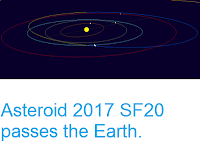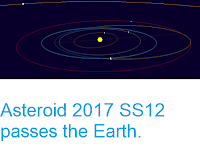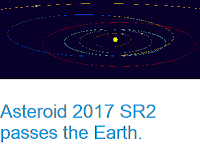Asteroid 2004 SS passed by the Earth at a distance of about 6 066 000
km (15.8 times the average distance between the Earth and the Moon, or 4.06% of the distance between the Earth and the Sun), slightly after 5.35 pm
GMT on Tuesday 26 September 2017. There was no danger of
the asteroid hitting us, though were it to do so it would have
presented a significant threat. 2004 SS has an estimated
equivalent
diameter of 75-240 m (i.e. it is estimated that a spherical object
with
the same volume would be 75-240 m in diameter), and an object at the upper end of this
size range would be predicted to be capable of
passing through the Earth's
atmosphere relatively intact, impacting the ground directly with an
explosion that would be 35 000 times as powerful as the
Hiroshima
bomb. Such an impact would result in an impact crater about 3.55 km in
diameter
and devastation on a global scale, as well as climatic effects that
would last decades or even centuries.
The calculated orbit of 2004 SS. Minor Planet Center.
2004 SS was discovered on 17 September 2004 by the Massachusetts Institute of Technology's Lincoln Near Earth Asteroid Research Laboratory in Socorro, New Mexico. The designation 2004 SS implies that it was the 18th asteroid
(asteroid S) discovered in the second half of September 2004 (period
2004 S).
2004 SS
has an 1188 day orbital period and an eccentric orbit
tilted at an angle of 6.52° to the plane of the Solar System, which
takes it from 1.04 AU from the Sun (i.e. 104% of he average distance at
which the Earth orbits the Sun) to 3.35 AU from the Sun (i.e. 3.35% of
the
average distance at which the Earth orbits the Sun, or over
twice the distance at which the planet Mars orbits the Sun). It is therefore
classed as an Amor Group Asteroid (an asteroid which comes close to the
Earth, but which is always outside the Earth's orbit).As
an asteroid probably larger than 150 m in diameter that occasionally
comes within 0.05 AU of the Earth, 2017 SN2 is also
classified as a Potentially Hazardous Asteroid (it comes no closer to
the Sun than 105% of the average distance at which the Earth orbit's the
Sun, but the Earth's orbit is not completely circular).
See also...
Follow Sciency Thoughts on Facebook.







